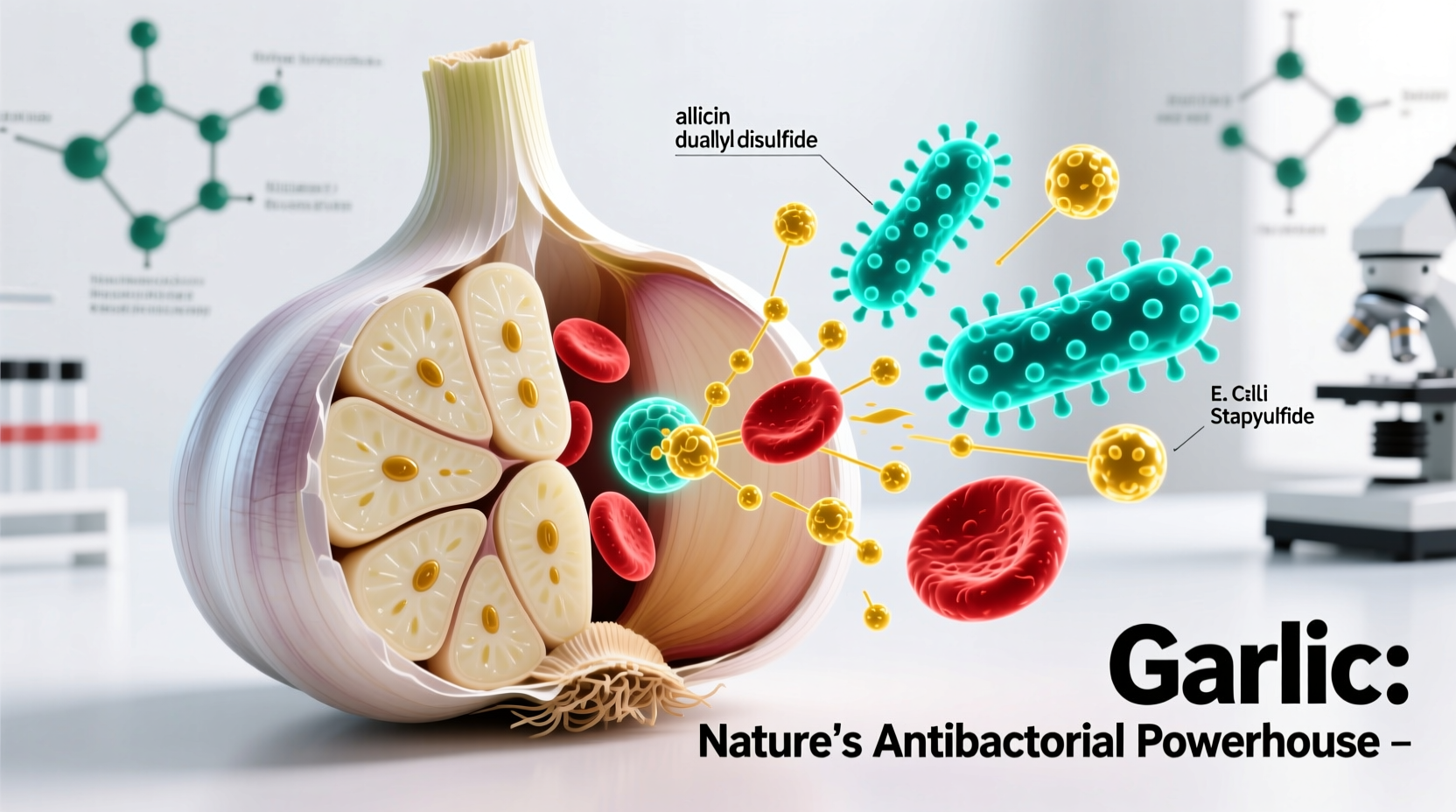Scientific research confirms garlic possesses genuine antibacterial properties, primarily through its active compound allicin. Studies show it can inhibit over 60 types of bacteria including E. coli and Staphylococcus aureus, though it should not replace prescribed antibiotics for serious infections.
For centuries, cultures worldwide have relied on garlic as a natural defense against infections. Modern science now validates these traditional uses with compelling evidence. As antibiotic resistance becomes a growing global health concern, understanding garlic's role as a natural antibacterial agent offers valuable insights for maintaining wellness through evidence-based approaches.
The Science Behind Garlic's Antibacterial Power
When you crush or chop fresh garlic, an enzyme called alliinase converts alliin into allicin—the compound responsible for garlic's potent antibacterial effects. This biochemical reaction happens within seconds, making freshly prepared garlic significantly more effective than processed forms.
| Garlic Compound | Antibacterial Mechanism | Effective Against |
|---|---|---|
| Allicin | Disrupts bacterial enzyme function | E. coli, Salmonella, Staphylococcus |
| Ajoene | Inhibits bacterial cell communication | MRSA, Pseudomonas aeruginosa |
| Diallyl sulfides | Penetrates biofilm barriers | Dental pathogens, H. pylori |
Research published in the Journal of Antimicrobial Chemotherapy demonstrates that allicin effectively disrupts bacterial metabolism by binding to essential enzymes. Unlike conventional antibiotics that target specific pathways, garlic's multiple active compounds create a broader antimicrobial effect, making it harder for bacteria to develop resistance.

How Garlic Works Against Bacteria: A Step-by-Step Process
Understanding garlic's antibacterial mechanism reveals why preparation method matters:
- Cell disruption: Crushing garlic releases alliinase enzyme
- Compound activation: Alliin converts to allicin within 10-15 seconds
- Enzyme interference: Allicin binds to bacterial thiol enzymes
- Metabolic disruption: Critical bacterial processes shut down
- Cell death: Bacteria cannot maintain essential functions
This multi-target approach explains why garlic remains effective against antibiotic-resistant strains. A 2022 study from Washington State University found garlic extract successfully penetrated MRSA biofilms that typically protect bacteria from conventional antibiotics.
Historical Use to Modern Validation: A Timeline
Garlic's journey from folk remedy to scientifically validated antibacterial agent spans millennia:
- 1550 BCE: Egyptian medical texts document garlic use for infections
- Ancient Greece: Hippocrates prescribed garlic for wound treatment
- World War I: Field medics used garlic juice as antiseptic when supplies ran low
- 1944: Scientists isolate and identify allicin as the active compound
- 2010s: Research confirms effectiveness against drug-resistant bacteria
- 2023: NIH funds studies on garlic compounds for topical antimicrobial applications
Practical Applications and Important Limitations
While garlic shows impressive antibacterial properties, understanding its appropriate use is crucial. The National Center for Complementary and Integrative Health emphasizes that garlic works best as a complementary approach, not a replacement for medical treatment.
When garlic may be appropriate: Minor skin infections, early cold symptoms, food safety applications
When professional medical care is essential: Systemic infections, fever, persistent symptoms, immunocompromised conditions
For maximum antibacterial benefit, use fresh garlic prepared correctly:
- Crush or chop cloves and wait 10 minutes before use
- Consume raw when possible (cooking reduces potency)
- Use within 2 hours of preparation (allicin degrades quickly)
- Pair with honey for topical applications (enhances antimicrobial effect)
Remember that individual responses vary significantly. A comprehensive review in Phytotherapy Research notes that garlic's effectiveness depends on preparation method, dosage, and the specific bacterial strain involved.
Integrating Garlic into Your Wellness Routine
Based on current research, here's how to safely incorporate garlic's antibacterial properties:
- For immune support: 1-2 raw cloves daily during cold season
- For food safety: Add crushed garlic to dishes to inhibit bacterial growth
- For minor skin issues: Create a paste with honey for topical application
- For dental health: Chew fresh parsley after garlic consumption
The Centers for Disease Control recognizes growing concerns about antibiotic resistance, making natural antimicrobial options increasingly relevant. However, they caution that natural doesn't always mean safe or appropriate for all situations. Always consult healthcare providers about persistent infections.











 浙公网安备
33010002000092号
浙公网安备
33010002000092号 浙B2-20120091-4
浙B2-20120091-4